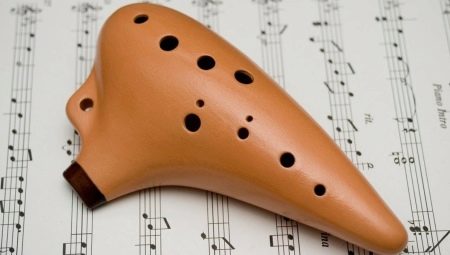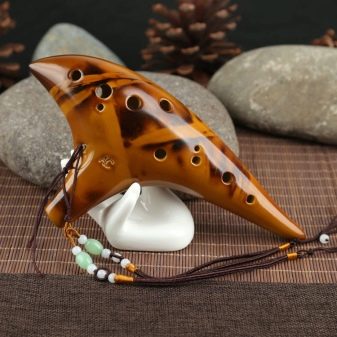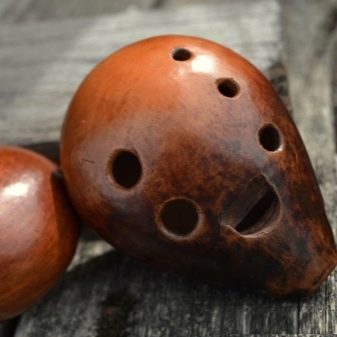All about the ocarina

Russia has long been famous for its craftsmen, whose handicraft and creativity impressed in the old days and continues to arouse the admiration of people. Among the main crafts that have received recognition all over the world, one can single out the Russian nesting doll, the Zhostovo tray, Khokhloma dishes and Gzhel ceramics. Without a doubt, the musical whistle deserves special attention - it was she who became the prototype of the musical instrument ocarina.


What it is?
The ocarina wind instrument is very diverse and can be found in various countries of the world. In music, its unusual sound has found application in a wide variety of musical styles - from pop music to folk music. In everyday life, the instrument can play the role of a signal device, children's play, be a talisman and even a ritual attribute.

The ocarina harmoniously combines with the sound of other instruments, so it is often included in strings, winds and even percussion ensembles. It sounds especially impressive in tandem with a symphony orchestra; it is no coincidence that famous groups often include it in their performances. There are even whole bands that only play the ocarina. Moreover, their repertoire is quite diverse, it includes melodies of various genres, even those that are far from ethnic.

The history of the ocarina in the form in which it appears to us now began not so long ago - from the second half of the 19th century. However, its prehistory goes back to the ancient era, when people just started to burn clay and make all kinds of objects from it for their everyday life. During archaeological excavations, prototypes of the instrument were discovered, the age of which is estimated at more than 10 thousand years ago.years. The geography of such finds is quite extensive - whistles were found in Asian countries, in Egypt, Romania, China, Korea, as well as in Africa and on the territory of the American continent.


The simplest whistle-type instruments were given an unusual look - they were made in the form of fish, figures of animals, birds and abstract forms. Altai ocarins even had the form of fantastic creatures - griffins. In the life of our distant ancestors, they played a very important role. In particular, in Russia, such whistles had a sacred meaning, they were often used when exposed to conspiracies, with their help they caused a downpour in a drought and drove away the dark forces.


However, researchers tend to assume that the prototype of the modern wind ocarina at the beginning of the 16th century. was brought to Spain by the Aztecs.
Charles V liked the performance of Mexican dancers and musicians so much that the artists were immediately sent on a trip to the countries of the Old World - so the instruments ended up in Italy. One of the concerts was attended by a successful Italian baker, an interesting instrument interested him, and he decided to make something similar. He cooked his whistles right in the ovens, which, after baking the rolls, kept warm for a long time.

Those first whistles made three to five sounds and were popular with children. One of the guys playing with the whistle was the boy Giuseppe Donati, who appeared in the small town of Budrio. From an early age he showed a great interest in the sound of instruments and knew how to masterfully handle the clarinet. He always liked the melody of the whistle, but the inaccuracy of intonation and the meager range did not suit the young musician. At the age of 16, for the sake of fun, the young man decided to improve the whistle toy.

The updated instrument already had ten holes, which made it possible to significantly expand the sound range and bring the tuning to the ideal. It was Donati who gave his invention the name "ocarina", which is translated from the Bolognese dialect as "gosling" - and in fact, in its configuration, the instrument resembled a feathered headless. The holes in the improved tool were arranged in two even rows, a couple more holes were provided on the sides, they were closed with thumbs. However, the work of the young inventor did not end there. Later he created several more varieties of the whistle, which differed in pitch and timbre.

Structure
The design of the ocarina is quite simple. This is a closed-type acoustic chamber with a whistle mechanism. The configuration of the instrument chamber is very different, it has holes for adjusting the key. The number of holes in the whistles varies from 4 to 12, most often 5.6 or 7. The instrument includes a mouthpiece with a mouthpiece, as well as an air duct, which is called windway. Near the mouthpiece, there is a window of the whistle device - a labium, and there is also an air stream divider - a tongue.

The modern wind instrument, as in the old days, is presented in many forms. It can resemble a geometric figure, as well as birds, fish and animals. It is made from a variety of materials, it can be ceramic, wood, clay, metal, plastic, polymer clay and even glass are often used for its manufacture.


It is believed that the wood ocarina is the closest relative of the flute. Nevertheless, there are fundamental differences between them. So, the flute is open on both sides, the whistle of the ocarina is covered. The tonality parameters of the flute sound directly depend on the air column. From the inside, it is controlled by closing and opening the holes, which is why they are located at a distance from each other. In ocarina, the tonality parameter depends on the difference in pressure values inside the whistle and outside. The pressure compresses and then expands the air spring. The highest notes are generated when the hole is opened.Such a structure significantly limits the range of sound of the ocarina, which is not the case with flutes.

Ocarina can be simple or complex in design. The first include single-chamber models with a small melody range. Complex - two-chambered or even three-chambered. Their range is up to three measures. The most modern products are equipped with a piston or valve mechanism, making it possible to change the action of the instrument.


Sound
The sound of the ocarina is soft and slightly hissing, while cold tones dominate in the timbre. The brightness and pitch of this whistle directly depends on the dimensions of the instrument. The smaller the acoustic chamber, the higher, cleaner and louder the whistle sounds. And vice versa, the larger the volume of the instrument, the quieter and softer the sound is.

The sound of an ocarina is formed as a result of the action of an air jet directed into the whistle. It causes the tongue to vibrate - the air is cut and creates vibrations, leading to the appearance of resonance inside the whistle. Ocarina sounds can represent piccolo, soprano, alto, as well as tenor and bass. All of them are combined into a single ensemble and allow you to perform melodies of all types of complexity - from classical to modern.

The ocarina can be distinguished by a chromatic or diatonic scale. On models with a diatonic tuning, chromatic sound is achieved if the holes overlap in fragments. In this case, the range is directly affected by the number of holes - the more there are in the instrument, the wider the range of sounds will be.



How do you learn to play?
The ocarina is popular all over the world. It is not surprising that many people want to learn how to play it. This is not difficult to do.

Customization
Due to the variability of the shape and volume of the instrument, adjustment is made after firing and decoration. At the same time, the closedness of the chamber, material and other structural features do not significantly affect the expansion. Even before firing, the working shape of the tongue is made and the parameters of the note holes are set, they are made small. After firing and decoration, tuning is carried out using a boring machine: in this case, all the note holes are closed, and the tongue is sharpened to the required note.

Technique of the game
To master the ocarina, it is not at all necessary to understand the intricacies of musical literacy. Nowadays, on the Internet, you can find lessons and tutorials, where the basic layout schemes and the necessary fingerings for various types of whistles are given. In general, the sequence of actions during the game includes the following movements.
- At first, the mouthpiece of the ocarina is slightly clamped by the lips, literally the very spine. Please note that the teeth should not participate in this movement.
- Relax your fingers and bend them slightly... The whistle holes are covered with pads. Sometimes in the process of learning the musicians miss and push past the hole, but with practice you will get used to hitting accurately and as quickly as possible.
- In moments when the little finger does not cover the back holes, the back of the ocarina should be supported with the little finger.
- Reed position during play: to play a note or to distinguish a line between them, try to whisper "tu-u" or "doo-u", starting to blow air, (and not the traditional "fu-u" for the flute).
- The air flow you send into the instrument should be calibrated and as uniform as possible. If you're not going to act like gusts of wind, don't blow out too hard.
- When playing high notes, bow your head slightly.
- Exercise every day. Let not for long, but regularly. And then you will definitely succeed!

Dross is an unpretentious musical instrument. But for a long time now, the army of his fans has only been growing. Nowadays, he has gained immense popularity in various parts of the world. The whistle can be heard in large concert halls, its sound penetrates the souls of hundreds of thousands of music lovers around the world. It is interesting and simple to play on it.






And in conclusion, here are some interesting facts related to this unusual tool.
- The largest collection of ocarinas is presented in the homeland of the instrument's creator Donati.
- During the First World War, the military often took ocarina into battle as a talisman. With its sound, it reminded them of their home and gave them strength.
- The sound of the ocarina is familiar to all residents of the former Soviet Union from the song "Belovezhskaya Pushcha" by the ensemble from Belarus "Pesnyary".
- In Italy, the whistle is often called "bologna sausage", and in America it is called "sweet potato pipe".
- in the 50s. of the last century, the ocarina has become one of the main hippie accessories.
- The Ocarina Festival is held twice a year in Italy.
- Japanese company Nintendo in the late 90s. presented a wind instrument in the cycle of her games "The Legend of Zelda". According to the plot, he has magical characteristics, helps to resist the forces of evil, and also moves to the future and past. The popularity of ocarina increased after the release of this game, which led to a surge in sales.
- In cinematography, the sound of this amazing instrument can be found in the title track to Sergio Leone's film "The Good, the Bad, the Ugly", the music for it was written by Ennio Morricone. Melodic chords are also discernible in the absurd comedy Monty Python's Meaning of Life.
- Famous bands such as The Troggs and Duran Duran have used the ocarina to arrange their songs. Whistle melodies are featured in the hits of the American singer Bing Crosby, the rock artist from Ireland Chris de Burgh, as well as in the songs of the English singer Katie Melua.
- The whistle is featured in Japanese animation. It is included in the audio sequence for the cartoons "My Neighbor Totoro", "Dragonball Z" and "Anpanman".
- By the way, a sports whistle, in its essence, can also be attributed to ocarinas. Its design is very similar to this simple tool.

Want to hear what an ocarina sounds like? Include the following video.








